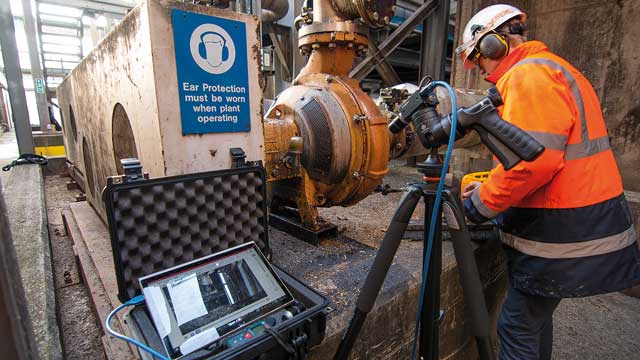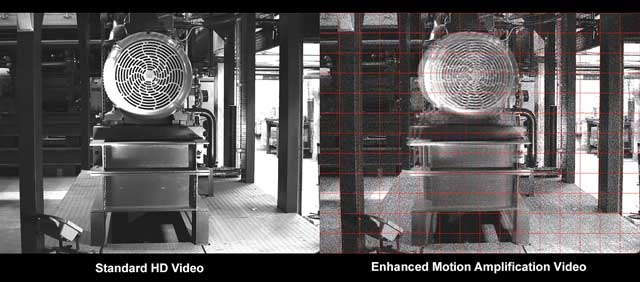
A new process has profoundly changed the capabilities of vibration analysis and has great untapped potential, says Keith Gallant, vibration analyst at RMS Reliability Maintenance Solutions
Motion amplification is a revolutionary new measurement and visualisation process for machine diagnostics. I don’t use the word revolutionary lightly. In vibration analysis there have been many innovations, but the advent of motion amplification has changed vibration analysis forever.
The revolution is described very simply. Motion amplification is the process of collecting multiple non-contact vibration measurements using a video camera and replaying the video with amplified measurement values. The technique allows you literally to see vibration on a machine or structure.
Motion amplification is a proprietary technology developed by Jeff Hay, the founder of RDI Technologies. The technology has been applied in a system called Iris M, which is a high-level data processing suite combined with a machine vision greyscale camera with a variety of lenses, and an acquisition laptop. The laptop powers the camera via USB and with the camera on a tripod you can move about quickly and freely.
The system is very quick. An average shot takes three seconds to collect and 30 seconds to amplify, and can be analysed immediately. You can also take much longer video to capture transient events, but the processing time increases.
My introduction to motion amplification came in autumn 2016. After overcoming our initial scepticism, my colleagues and I took motion amplification to all our known repeat issues and have solved many of them. I have used it for quick diagnostics on problems where it would normally have taken a long time to collect and process data; I’ve used it on areas of machines where we would never look for a root cause, and solved problems that have plagued machines for many years. We have identified weak points on pipework, large building structures resonating, looseness in components that look solid to the eye, bent shafts, and slow speed misalignment not detectable with normal accelerometers.

The process
How does motion amplification work? If you can see an object, photons of light are reflecting off it. If that object has any displacement with a regular frequency, the photons of light may contain that information, so we use the latest camera technology to sense that displacement.
Essentially each pixel is now a motion sensor. The Iris M system measures photons of light at each pixel in the camera, for each frame. When sampled at twice the frequency of interest, or faster, we can resolve an accurate vibration signal at all 2.3 million pixels.
Having an accurate vibration measurement value across the image, we can collect a displacement measurement waveform and spectrum for anywhere in the frame.
The visual side allows us to amplify all those points in the video and see that vibration in action.
A really useful feature of the process is the ability to add signal filters to control which frequencies are visible in the video. So you can reject motion at a specific frequency and see the effect of another frequency of interest, allowing you to understand how different frequencies are influencing a system, and which are problem vibrations and which are not.
Interchangeable lenses add a new dimension: you can measure the vibration on the nacelle of a wind turbine a mile away. If you have a reciprocating compressor with a multitude of pipework and components coming from it, you can stand a few metres back and measure everything at once..
The ideal conditions for using the technology are outlined below.
- Low frequency problems – up to 650Hz
- The technique excels on 1x and 2x vibration problems on rotating equipment
- Pipework vibration surveys
- Structures with vibration
- Frequency analysis testing of new machine builds
- Verification scans after repair/installation work
- Investigation of the effectiveness of vibration damping/supports
- Identifying the root cause of process issues
- Any moving part with a regular frequency.
Some significant faults we have been able to solve include:
Unsolved Misalignment – For over five years on a routine vibration survey a motor and pump showed apparent signs of misalignment, but when physically checked appeared to be in good alignment. There were no visual signs of problems with the base; all the anchor bolts were solid and structural integrity seemed good.
With motion amplification it was apparent that the motor was rocking at a frequency corresponding to twice the running speed, and within 15 minutes we found the motor baseplate was flexible and allowing vertical motion at this frequency. The baseplate was replaced on the next shutdown.
Pipework Failures on a Pump System – Repeat pipework failures were blamed on process issues and no consideration was given to other root causes. A series of filters were used to reject unwanted frequencies from the video and only visualise the problem frequency on the pipework, revealing the root cause to be a loose pump foot.
I am convinced that yet more applications for this technology will emerge. Where would you put 2.3 million sensors if you could?
How to use motion amplification
- Start wide – video a wide area around the region of interest
- Look for motion in the video
- Move your focus to the area of motion, increase resolution
- Filter video to the frequencies of interest
- Export to mp4 to show colleagues.

